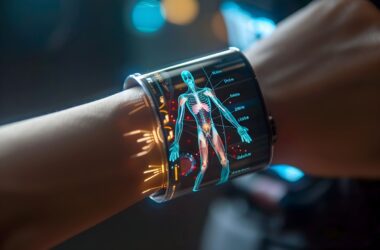The operating room has long been a realm of exceptional skill and meticulous precision. Yet, even the most experienced surgeons face limitations in visualizing anatomy and navigating complex procedures. Fortunately, a revolutionary technology is emerging that promises to transform surgery and significantly improve patient outcomes: Augmented Reality (AR) Surgical Techniques.
With an unprecedented potential to enhance surgical accuracy, this innovative technology is gaining incredible market value. According to a media release, the global healthcare AR & VR market size was valued at roughly USD 2301.47 million in 2022. It is expected to grow at a CAGR of 18.01% and reach a value of USD 8654.28 million by 2030.
AR in surgical techniques overlays digital information onto the surgeon’s real-world view, offering unprecedented visualization and guidance during critical procedures.
AR Surgery – A Closer Look
Often used together, AR surgery differs profoundly from virtual reality (VR) surgery. VR creates an entirely immersive, computer-generated environment. In contrast, AR seamlessly combines digital information with the surgeon’s actual view of the patient. This effect is achieved through sophisticated head-mounted displays (HMDs) or holographic projections that project critical information directly into the surgeons’ line of vision.
With the latest advancements, AR technology has secured an unparalleled place in the operating room. Improved display resolution and processing power facilitate high-fidelity overlays. At the same time, real-time data integration enables surgeons to access critical healthcare information like CT scans and MRIs directly in the surgical field.
Advantages Of AR Surgery
The transformative potential of AR surgery is no longer theoretical. Here are some effective examples of its life-saving applications across various medical specialties:
- Brain Surgery: Neurosurgeons use AR to visualize intricate brain structures during tumor resections and implantations. This technology enables them to perform more precise procedures while minimizing risks to delicate neural pathways.
- Orthopedic Surgery: AR overlays can guide surgeons in performing complex joint replacements with greater accuracy, leading to improved implant positioning and faster patient recovery.
- Minimally Invasive Surgery: AR technology enhances laparoscopic and robotic surgery by giving surgeons a magnified view of the surgical field and real-time guidance on instrument placement. This technology helps them to reduce the need for large incisions and allows for faster patient recovery times.
These are just a few mainstream examples, and the potential applications of AR surgery continue to expand rapidly in diverse specialties. Researchers are actively exploring AR applications for other specialties, including cardiac surgery, plastic surgery, and even dental procedures.
The Future Role Of AR In Medical Care
As AR technology continues to progress, its role in medical care is poised to become even more noteworthy. Here are some exciting possibilities on the horizon:
Personalized Medicine: AR can be used to create patient-specific overlays based on an individual patient’s anatomy and medical record. This level of personalization will further improve surgical precision and enhance patient outcomes.
Artificial Intelligence Integration: The integration of AI with AR will create intelligent surgical assistants that can deliver real-time feedback and decision support to surgeons during complex surgical procedures.
Remote Surgery And Disaster Relief: Advancements in AR communication technology will pave the way for across-the-board adoption of remote surgery, allowing specialists to operate on patients in locations where specialist care is unavailable. This holds immense potential for improving healthcare access in remote areas and during emergencies.
Conclusion: A Brighter Future For Patients And Surgeons
The rise of augmented reality in surgical techniques is a turning point in the annals of healthcare. By delivering unprecedented visualization, improved precision, and enhanced collaboration, AR surgery is transforming the operating room and saving lives. This technology enables surgeons to achieve remarkable outcomes, minimizing risks and accelerating patient recovery times. The future role of AR in medical care promises to be even brighter, with personalized medicine, AI-powered assistance, and remote surgery capabilities becoming a reality. This innovative technology represents a giant leap forward, paving the way for a future where patients everywhere can benefit from the expertise of the world’s leading surgeons, regardless of location.
Frequently Asked Questions About Augmented Reality (AR) In Surgical Procedures
1. What is Augmented Reality (AR) in surgery?
In surgery, AR harnesses digital overlays that enhance a surgeon’s view of the operating area. By integrating real-time data, such as CT scans and MRI images, directly into the surgeon’s field of vision, AR helps improve precision and visualization during critical surgical procedures.
2. What’s the primary difference between AR and Virtual Reality (VR) in surgical settings?
While Virtual VR creates an entirely immersive environment, Augmented Reality (AR) blends digital information with the real-world environment. This means that during an AR-assisted surgery, surgeons can see the actual surgical field and the digital overlays simultaneously, which is not possible with VR.
3. State some primary benefits of using AR in surgery.
The primary benefits of using AR in surgery include enhanced visualization of the surgical field, increased precision and accuracy, limited error risks, and improved patient outcomes. Additionally, AR equips surgeons with better training and facilitates seamless remote collaboration among medical professionals.
4. Can AR in surgery help with training new surgeons?
Yes, AR can remarkably enhance the training of new surgeons. It allows for realistic, interactive simulations of complex surgical procedures, helping trainees to develop their skills safely and efficiently. This hands-on experience is crucial in preparing new surgeons for real-world operations.
5. Are there any specific types of surgeries that benefit most from AR?
AR technology is particularly beneficial in complex and minimally invasive surgeries such as neurosurgery, orthopedic surgery, and laparoscopic procedures. It provides detailed visuals and precise guidance, which are critical in surgeries where the margin for error is minimal.
[Looking to reach more on Health Tech? Explore this: 3D Bioprinting—How Close Are We To This Miracle?]













